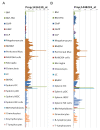Prion disease and the innate immune system
- PMID: 23342365
- PMCID: PMC3528271
- DOI: 10.3390/v4123389
Prion disease and the innate immune system
Abstract
Prion diseases or transmissible spongiform encephalopathies are a unique category of infectious protein-misfolding neurodegenerative disorders. Hypothesized to be caused by misfolding of the cellular prion protein these disorders possess an infectious quality that thrives in immune-competent hosts. While much has been discovered about the routing and critical components involved in the peripheral pathogenesis of these agents there are still many aspects to be discovered. Research into this area has been extensive as it represents a major target for therapeutic intervention within this group of diseases. The main focus of pathological damage in these diseases occurs within the central nervous system. Cells of the innate immune system have been proven to be critical players in the initial pathogenesis of prion disease, and may have a role in the pathological progression of disease. Understanding how prions interact with the host innate immune system may provide us with natural pathways and mechanisms to combat these diseases prior to their neuroinvasive stage. We present here a review of the current knowledge regarding the role of the innate immune system in prion pathogenesis.
Figures



Similar articles
-
Type I interferon protects neurons from prions in in vivo models.Brain. 2019 Apr 1;142(4):1035-1050. doi: 10.1093/brain/awz016. Brain. 2019. PMID: 30753318 Free PMC article.
-
The role of the immune system in prion infection.Handb Clin Neurol. 2018;153:85-107. doi: 10.1016/B978-0-444-63945-5.00005-2. Handb Clin Neurol. 2018. PMID: 29887157 Review.
-
The peripheral nervous system and the pathogenesis of prion diseases.Curr Mol Med. 2004 Jun;4(4):355-9. doi: 10.2174/1566524043360618. Curr Mol Med. 2004. PMID: 15354866 Review.
-
The spread of prions through the body in naturally acquired transmissible spongiform encephalopathies.FEBS J. 2007 Feb;274(3):588-605. doi: 10.1111/j.1742-4658.2007.05631.x. FEBS J. 2007. PMID: 17288548 Review.
-
Prion diseases and the immune system.Clin Immunol. 2000 Aug;96(2):79-85. doi: 10.1006/clim.2000.4875. Clin Immunol. 2000. PMID: 10900153 Review.
Cited by
-
A unified pathogenesis for kidney diseases, including genetic diseases and cancers, by the protein-homeostasis-system hypothesis.Kidney Res Clin Pract. 2017 Jun;36(2):132-144. doi: 10.23876/j.krcp.2017.36.2.132. Epub 2017 Jun 30. Kidney Res Clin Pract. 2017. PMID: 28680821 Free PMC article. Review.
-
Accelerated onset of CNS prion disease in mice co-infected with a gastrointestinal helminth pathogen during the preclinical phase.Sci Rep. 2020 Mar 12;10(1):4554. doi: 10.1038/s41598-020-61483-4. Sci Rep. 2020. PMID: 32165661 Free PMC article.
-
Type I interferon protects neurons from prions in in vivo models.Brain. 2019 Apr 1;142(4):1035-1050. doi: 10.1093/brain/awz016. Brain. 2019. PMID: 30753318 Free PMC article.
-
Insights into Mechanisms of Chronic Neurodegeneration.Int J Mol Sci. 2016 Jan 12;17(1):82. doi: 10.3390/ijms17010082. Int J Mol Sci. 2016. PMID: 26771599 Free PMC article. Review.
-
Infectious particles, stress, and induced prion amyloids: a unifying perspective.Virulence. 2013 Jul 1;4(5):373-83. doi: 10.4161/viru.24838. Epub 2013 Apr 30. Virulence. 2013. PMID: 23633671 Free PMC article. Review.
References
-
- Prusiner S.B. Novel proteinaceous infectious particles cause scrapie. Science. 1982;216:136–144. - PubMed
-
- Fraser H., Dickinson A.G. Pathogenesis of Scrapie in the Mouse: The Role of the Spleen. Nature. 1970;226:462–463. - PubMed
-
- Glaysher B.R., Mabbott N.A. Role of the GALT in Scrapie Agent Neuroinvasion from the Intestine. J. Immunol. 2007;178:3757–3766. - PubMed
Publication types
MeSH terms
Grants and funding
- BB/F019726/1/BB_/Biotechnology and Biological Sciences Research Council/United Kingdom
- BBS/E/D/20251968/BB_/Biotechnology and Biological Sciences Research Council/United Kingdom
- BBS/E/I/00000989/BB_/Biotechnology and Biological Sciences Research Council/United Kingdom
- BBS/E/D/20251967/BB_/Biotechnology and Biological Sciences Research Council/United Kingdom
- BBS/E/A/00001660/BB_/Biotechnology and Biological Sciences Research Council/United Kingdom
LinkOut - more resources
Full Text Sources
